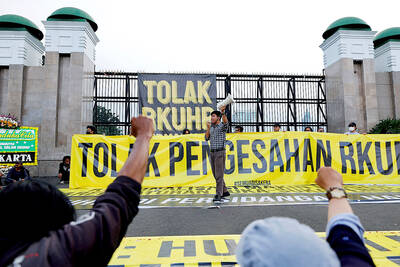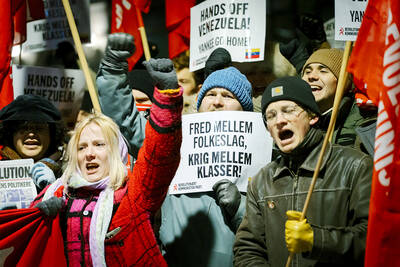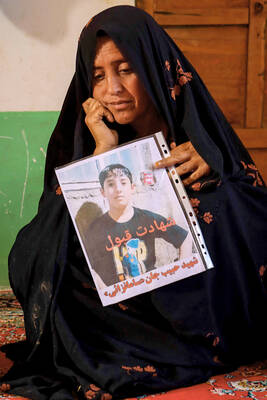The mystery of Russia’s famed Amber Room, seized as spoils of war by the Nazis, has puzzled historians and experts since it disappeared in 1945.
Sergei Trifonov, however, believes he has solved the riddle, and that the treasure — ornately carved panels of glowing amber, formed from fossilized resin — lies underneath a bunker in the Russian enclave of Kaliningrad.
“Believe me or not, it’s there, 12m down in the sub-soil,” he said, pointing to the entrance of a bunker that sheltered the Nazi high command in the last hours of the Battle of Koenigsberg.
“This place was built [in February 1945] with two aims: accommodating the headquarters of General Otto Lasch and storing the treasures of Koenigsberg, a city under siege,” the historian turned journalist and lecturer said.
Koenigsberg, in what was then German East Prussia, is now Kaliningrad, the capital of Russia’s westernmost region of the same name.
The Nazis removed the treasure from a palace that once belonged to empress Catherine the Great outside Saint Petersburg after invading the Soviet Union in 1941.
Once hailed as the eighth wonder of the world, the trophy was brought here and stored in the former castle of the Teutonic Knights in the center of the city.
But its subsequent fate remains unknown amid the turmoil of war and heavy bombardment of the city by the Allies.
The Red Army seized the ruined city on April 9, 1945. Stalin triumphantly annexed it and renamed it Kaliningrad, after a leader of the Supreme Soviet.
The Amber Room — with its 35m² of panelling — was sighted in the last month of the final attack, after it had been disassembled and stored in cases.
After that, it vanished.
There are many theories about what happened next. The panels may have been destroyed by bombs, secretly moved to Germany or hidden in the maze of tunnels under Kaliningrad.
To test his theory, Trifonov has begun to probe the soil under the bunker using a ground-penetrating radar, and pump out water. He has already unearthed a brick-lined room.
The bunker is 300m from the site of the castle — demolished in 1967 — that sheltered the Amber Room. Its iron gate features Viking symbols and a Teutonic cross, suggesting it wasn’t only for military use, Trifonov ssaid.
“I’m sure that the Amber Room wasn’t taken away. The theory that it is now in Germany doesn’t make sense,” he said.
“If that was so, the Germans would have found it,” he said.
Working alone with help from several sponsors, Trifonov said his supporters include Kaliningrad’s governor. Nevertheless, not everyone takes his theories seriously.
“He’s a good storyteller who can’t prove anything,” said Vladimir Kulakov, an expert at Russia’s Institute of Archaeology, who has also dug in the soil under the bunker in search of the Amber Room.
Anatoly Valuyev, deputy director of Kaliningrad’s History and Art Museum, which takes in the bunker, was more circumspect.
“It’s good that people think that the treasure is there. They have energy and the museum gains from this,” he said, citing the water being pumped out.
“We still hope that the [Amber] Room is somewhere in Kaliningrad,” he said. “There are plenty of underground sites left to explore. If they don’t find it here, they’ll look elsewhere.”
A reconstruction of the Amber Room was opened at the Catherine Palace near Saint Petersburg in 2003.

Indonesia yesterday began enforcing its newly ratified penal code, replacing a Dutch-era criminal law that had governed the country for more than 80 years and marking a major shift in its legal landscape. Since proclaiming independence in 1945, the Southeast Asian country had continued to operate under a colonial framework widely criticized as outdated and misaligned with Indonesia’s social values. Efforts to revise the code stalled for decades as lawmakers debated how to balance human rights, religious norms and local traditions in the world’s most populous Muslim-majority nation. The 345-page Indonesian Penal Code, known as the KUHP, was passed in 2022. It

‘DISRESPECTFUL’: Katie Miller, the wife of Trump’s most influential adviser, drew ire by posting an image of Greenland in the colors of the US flag, captioning it ‘SOON’ US President Donald Trump on Sunday doubled down on his claim that Greenland should become part of the US, despite calls by the Danish prime minister to stop “threatening” the territory. Washington’s military intervention in Venezuela has reignited fears for Greenland, which Trump has repeatedly said he wants to annex, given its strategic location in the arctic. While aboard Air Force One en route to Washington, Trump reiterated the goal. “We need Greenland from the standpoint of national security, and Denmark is not going to be able to do it,” he said in response to a reporter’s question. “We’ll worry about Greenland in

PERILOUS JOURNEY: Over just a matter of days last month, about 1,600 Afghans who were at risk of perishing due to the cold weather were rescued in the mountains Habibullah set off from his home in western Afghanistan determined to find work in Iran, only for the 15-year-old to freeze to death while walking across the mountainous frontier. “He was forced to go, to bring food for the family,” his mother, Mah Jan, said at her mud home in Ghunjan village. “We have no food to eat, we have no clothes to wear. The house in which I live has no electricity, no water. I have no proper window, nothing to burn for heating,” she added, clutching a photograph of her son. Habibullah was one of at least 18 migrants who died

Russia early yesterday bombarded Ukraine, killing two people in the Kyiv region, authorities said on the eve of a diplomatic summit in France. A nationwide siren was issued just after midnight, while Ukraine’s military said air defenses were operating in several places. In the capital, a private medical facility caught fire as a result of the Russian strikes, killing one person and wounding three others, the State Emergency Service of Kyiv said. It released images of rescuers removing people on stretchers from a gutted building. Another pre-dawn attack on the neighboring city of Fastiv killed one man in his 70s, Kyiv Governor Mykola